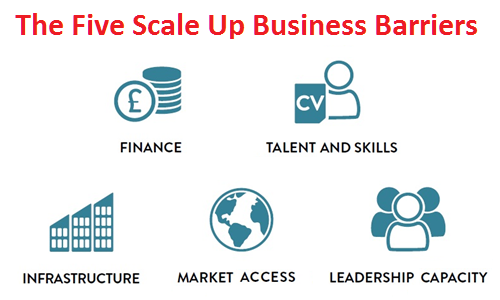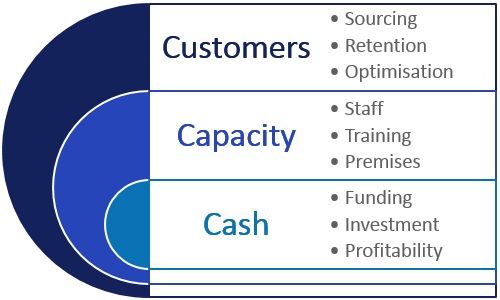What if you could have your own motorway lane to get to work and then drive at whatever speed you wanted, rather than fighting with all of the other commuters for lane space and suffering all the usual speed restrictions. You’d probably jump at the chance.
Fighting for space, what you experience going in to work every day, is what it’s like for millions of business users, employees and partners with poor internet speeds.
Internet speed is holding back British business
Let’s be honest, what was fast internet access a few years ago is pretty slow today. We’re all used to our new mobile moving to the latest ‘G’ when we upgrade every two years or so, and then suddenly we can see live streamed footage of our favorite sports team, seamlessly, in high resolution. So why hasn’t business kept up with high speed internet at the same pace?
These days high speed exchanges feed broadband internet into most UK towns and cities, and the UK now has 95% coverage for broadband with speeds of 24 Megabits per second or higher. However, many businesses are stuck at the mercy of the rickety old telephone wires that are limited in the speeds they can support. If it’s copper wires that link a business premise to the high speed exchange cabinet, which might even be miles away, then this can create grindingly slow broadband connections for staff.
For fast, reliable business broadband, a full fibre optic cable connection is required. Fibre is capable of delivering Gigabit speeds, and one Gigabit is 1,000 Megabits, so it’s a big leap forward in connection speeds that could benefit you and your business into the future. But the key challenge for most smaller businesses has not so much been the cost of Gigabit speed line rental, but the high cost of installation of this type of high speed line to their premises.
UK Government Gigabit Broadband Voucher Scheme (GBVS)
Launched in March 2018 the GBVS is a £67m UK government fund that currently runs until March 2019. GBVS is a grant contribution to pay towards upgrading broadband to a high-speed Gigabit capable connection. To put it in context, to stream an HD movie you would need a connection speed of about 5 Megabits per second (Mbps), so with a 1 Gbps line up to 200 people could watch an HD movie simultaneously . Full fibre also supports symmetrical connections – meaning your upload and download speeds can be the same.
Most UK small and medium sized organisations, in all sectors, with 1 to 250 employees and less than £50m turnover, could be eligible for a GBVS grant of up to £3,000. This grant can be used to help pay for a high speed broadband connection as part of a group project, or directly to a single business premises.
This is how the Gigabit Broadband Voucher Scheme works, managed by the UK Government Department for Culture Media and Sport.

- Find out if you are eligible for the GBVS scheme – click here
- Find out how NUCO International has benefited – click here
Why high speed Internet is crucial for your business
Mobile devices are actually part of the problem many businesses now have. New faster mobiles and BYOD (Bring Your Own Device) programs, supporting workers’ own and business smartphones and tablets, incrementally grow the demand for Internet bandwidth. More people and more high speed Internet-linked devices in your company simply soaks up your limited bandwidth, and also the speed that bandwidth can deliver when accessed almost all the time. And it’s the same effect whether people are connected to your internet by cable, or using company Wi-Fi to manage business requirements on a PC or mobile.
At home, the lack of a high speed internet connection may be frustrating, with occasional breaks in your movie or the ‘spinning wheel of death’ as content buffers. But, with your business, slow internet speed is a potential future killer. It’s not just the lost productivity, when your staff can’t upload and download files they’ve been sent on email quickly, it’s the lack of options you then have to make your staff more productive, and to collaborate with each other more easily.
Don’t despair, here are just five of the opportunities that businesses with high speed Internet can make the most of straight away, today:
Cloud computing applications
Most people have heard of this and examples of cloud computing are things like mobile email, social media and Spotify that we all use at home. But, in business, growth in cloud computing services and resources can keep your employees more focused and more productive. For example they could use products like Microsoft’s Office 365 to access meeting details, contacts or emails on their laptop or mobile, or contribute to a team conversation via an online project site. And all of this information and data is synchronised in real time in the cloud, inevitably requiring a consistently fast connection to the internet. The longer the response time from an outside resource, like a cloud based Customer Relationship Management (CRM) system, the more that users can waste time and lose focus on their business task at hand. Since the number of applications hosted by cloud providers have jumped a hundredfold in the last five years, companies need to upgrade their Internet connections urgently to maintain quick response times, and so their staff can interact and contribute rapidly, and remain constantly productive.
Big emails and multimedia websites
These days businesses rarely send the two or three line emails of old. Email has become a lot more visual, and photos and graphics have become part of almost every message, helping to share ideas and better explain the wider concepts of projects. They say a picture is worth 1,000 words, but a 500 page document written in Microsoft Word is about the same size as one email picture attachment. Not only that, but modern websites have abandoned pages of text for shiny new websites with photos, logos, banners and, increasingly, high resolution videos. All of these inevitably require far more bandwidth, in order to avoid longer load times to view them. Video streaming takes even more bandwidth. Few will notice the speed loss when one or two staff click on the latest video on YouTube. But when you’re talking about streaming business webinars, as well as streaming instructional videos or online courses, your bandwidth can disappear in a hurry and other important work using the internet can very soon slow to a crawl.
VoIP telephones
VoIP stands for Voice over Internet Protocol. It has become the dominant technology as businesses have brought in new VoIP phones to replace older landline systems. There are many great reasons to switch to VoIP, including things like caller recognition, but each VoIP conversation takes about 100Kb of bandwidth each and every second. If your company has just a few employees then that’s rarely a problem, but if you have 20 staff on the phone at any one time, you could easily max out all of your upstream speeds on most common business Internet plans. Without the right speed connection, call quality and data traffic also both suffer. A high speed Internet connection requires an ample supply of upstream bandwidth to maintain high-quality, real-time VoIP conversations, but high speed fibre connection services will have carrier service level agreements in place to provide and guarantee these high quality voice connections.
Video conferencing
When every company is looking for ways to increase the pace of their business by improving collaboration, whilst at the same time reducing travel time and costs, it is no surprise that video conferencing has become a lot more popular. With many low cost video conferencing products now available, the lure to push a button rather than book a flight for business meetings is very strong for both business team managers and accountants. It’s easy to understand why more businesses are moving to video conferencing every day, and high speed Internet service means better video meetings and increased staff productivity. But since images require a lot more bandwidth than text, streaming video consequently demands plenty of Internet bandwidth. Slow Internet speeds mean bad meetings, broken connections and frustrated staff, especially if some contributors in a different global location have got up specially to attend the video meeting.
Protecting your valuable data and files
Beyond basic local file backup, all companies recognise that backing up data offsite simplifies business continuity and disaster recovery planning. With more high resolution video, photos and diagrams, the amount of data backed up is constantly growing. Backing up their data using a slow Internet connection creates lots of problems, even if backup is scheduled to run overnight. High-speed Internet connections make rapid, complete backups possible, protecting your critical data and ensuring your business can continue, even if you suffer a data loss due to equipment failure, disaster or data theft. As of May 2018 there’s also the GDPR regulations to consider, where you need to make sure that any data that you hold on individuals is securely held, processed and backed up in line with stringent regulations that apply to all sizes of organisation.
Conclusion
Few of us would also have guessed at half of the devices that have arrived over the last ten years that use an Internet connection. Who knows what web-enabled bit of kit might hit the market next, especially with the Internet of Things?
Wouldn’t it be a crime if you couldn’t download that critical business email attachment simply because your Internet-enabled fridge was doing the drinks stock-up order at an online supermarket?
But, seriously, if you want to remain technologically fit for the future then the lack of high speed broadband could become a life threatening barrier to your business efficiency, or it could drastically limit your planned growth and success.
Get Gigabit speed connected. Find out about the GBVS today here.









